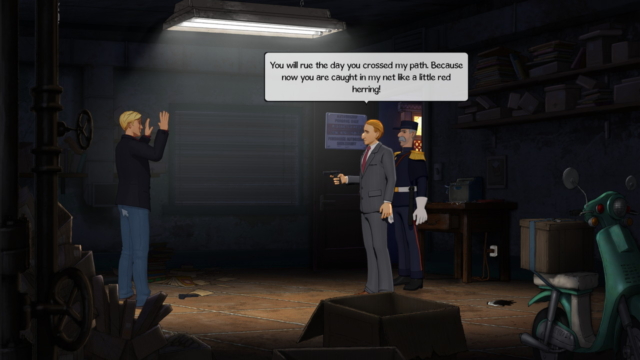
Broken Sword 5: The Serpent’s Curse
Written by: Rik
Date posted: August 3, 2019
- Genre: Adventure
- Developed by: Revolution Software
- Published by: Revolution Software
- Year released: 2013
- Our score: 7
The adventures of George Stobbart took a detour in the mid-00s, for reasons of commercial viability more than anything else, with gaming’s favourite American tourist re-imagined as a hunky explorer adept at grabbing onto ledges and moving around crates for the series’ first foray into 3D, 2003’s The Sleeping Dragon, before reverting to more traditional adventure game territory, albeit still in 3D, in 2006’s The Angel of Death. At some point, though, the pervading industry belief that 2D point and click adventures were best consigned to the past was abandoned, and, buoyed by the success of a new so-called ‘Director’s Cut’ re-release of the first game and the aid of the kind of crowdfunding campaign that proved so popular in the early part of this decade, this fifth instalment – The Serpent’s Curse – promised a more wholesale return to roots.
Broken Sword 5 certainly doesn’t hang around in terms of getting into familiar territory: after a brief prologue, we have a voice-over from George, announcing that he’s back in Paris again, this time as an insurer for an art gallery, and has somehow contrived to meet up with ex-girlfriend and long-time series accomplice, Nico Collard. This being George, though, things go wrong almost immediately: a painting is stolen, a man is killed, and the police seem to have no clue. So George and Nico must work together to track the killer, and the painting, across multiple locations and continents, solving many other little puzzles and negotiating other temporary inconveniences along the way.
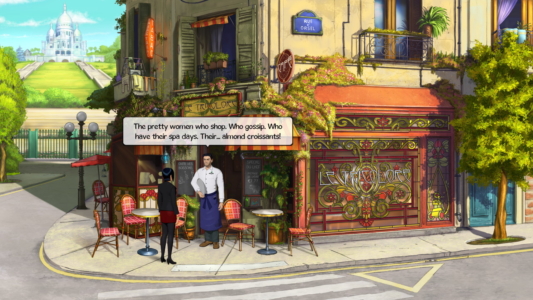
This waiter seems like the type who spends his spare time starting arguments with women on the internet.
For those firmly wedded to the idea of Broken Sword as a Parisian adventure with beautiful cartoon graphics, The Serpent’s Curse will immediately seem like a more worthy successor to the first two games than the 00s 3D efforts mentioned above. It’s been designed to stay faithful to that original aesthetic, and those with nostalgic feelings and faulty memories will be tempted to say it looks exactly the same (it doesn’t though, this is – obviously – a lot more swish and fancy). But it certainly feels the same, and as George says, it does feel good to be back in Paris. The backgrounds are gorgeous, the music gently evocative of the original, and the characters look good and move well.
The only slight downsides are the slight delays during actions and conversations which sort of break the flow at times, and occasionally interactions with the environment are slightly lacking, but otherwise, first impressions are good. The interface will be familiar to anyone who’s played an adventure game before, with few tweaks from the original games, and although the conversation system does retain a symbol-based aesthetic, there’s less repetition and George will refuse to discuss inventory items if they aren’t relevant, so the option to run around town showing everyone your dirty tissue isn’t available here. Rolf Saxon returns as the voice of George, although the actor playing Nico has indeed changed once again. Elsewhere, the acting is of the level and style in keeping with previous games – somewhere between a daytime radio play and a lightweight BBC sitcom (particularly, as previously mentioned, ‘Allo ‘Allo).
The Serpent’s Curse was originally released in two parts, and – logically enough – they form two distinct halves: first, looking for the painting and the killer, before delving into all the mystical mumbo-jumbo surrounding the motivations for the theft. As previously noted, I much preferred the first part: what some may consider the more mundane task of investigating and solving a crime, and negotiating daft situations along the way, is what I remember most fondly about Broken Sword, and for my money this is the strongest game of the series in this regard. Perhaps it’s my fondness for detective work (CSI, a curiously dated target for satire by this point, is roundly mocked here, in the form of a pompous policeman who favours physical evidence and crime scene reconstruction ahead of all else) but bumbling around Paris talking to people and dealing with situations and puzzles grounded in the real world (even if the way to negotiate them is often far-fetched) is more up my street than the travelling to ancient sites and decoding symbols while enduring lengthy monologues about mystic powers.
The first half also benefits from nicely pitched difficulty and a logical setup: like previous games, it keeps you hemmed into certain locations at times, so if you’re stuck, you know that it’s something you’re not quite getting, not that you should be somewhere else or missing a piece of inventory. Puzzles are perhaps on the easy side, although on more than one occasion there’s a nice little bait and switch where something seems to be handed to you on a plate (e.g. a crowbar near a locked door) but then it doesn’t quite work as you’d expect, although the eventual solution is never that far away. If you need more help, there’s a well-designed hint system which offers various levels of assistance depending on how much you need, from an actual hint simply pointing you in the right direction at one end of the scale, to a full solution outlining exactly what do next at the other.
(While we’re talking about puzzles in this first section, it’s probably worth mentioning a particularly memorable one, which not only rivals this contender for least ethical solution of all time, but also manages to reference another infamous example of incredulous adventure game logic. I can’t say too much more, but you’ll know it when you see it!)
After a reasonably exciting cliffhanger that brings the first part to a close, the second begins with a location that’s heavy with quite tricky puzzles and long, dull exposition. If you’ve always found the Dan Brown/Indiana Jones elements of Broken Sword the most interesting parts of the series, then you may not feel the same way, but personally I don’t think I can recall the pertinent details of the overriding plot, or climactic scenes, of any of the previous games. Certainly I zoned out at several points here as an elderly Spanish man went into ponderous detail about various bits of history and religion.
And there are a number of puzzles based on decoding patterns or symbols – again, which some may enjoy – that I personally had little patience for. I also wasn’t convinced they were always explained all that well, and even seeking light advice from the hint menu didn’t always make things clear. (That’s in contrast to the first part, where at times George’s voice-over almost goes too far in explaining what he thinks needs to happen next). I suppose games traditionally do get more challenging as you progress [are you sure you never thought of being a professional writer? – FFG reader] but I don’t think that entirely explains away the problems I had. All of this is not to say that there aren’t good bits in the second half, just that it seems like a disappointment in comparison to the first.
The other thing that’s worth addressing is the general tone of the thing: in staying very faithful to the previous games, there are elements of Broken Sword 5 that now seem very dated – not in terms of anything aesthetic, but in terms of the writing. The more you think about it, the more Broken Sword seems like a very odd beast, and I do wonder how those without prior experience of the series would experience this one (although from a story point of view it’s perfectly possible to start here). Some fairly fundamental (and familiar) questions come to mind: how old are George and Nico? What is the deal with those two? Is this meant to be a knockabout comedy or a serious thriller caper? And do we really need so many cameos from incidental characters in previous games?
We find out so little about our heroes throughout the course of the series, and even at the end of this one, when there seems to be some kind of payoff in this regard, it all falls apart under rather tasteless circumstances. Without being anything like up to date with the genre, but having experienced adventures like the brilliant Blackwell series in the recent past, Broken Sword’s whole approach seems a little uneven and juvenile. This is the kind of game where characters hiccup to show they’re drunk and the solution to one puzzle is to cheer someone up by playing a tune using a mop and some paint cans.
I suppose what I’m saying is: Broken Sword 5 is probably the best of the series, but in a way…after all this time, so it should be. Gripes aside, though, it certainly shouldn’t be a let down for fans, while even those with only a passing affection for previous efforts will have difficulty resisting the crowd-pleasing approach and callbacks to the first game. (As with the original, there is something magical about the beautifully drawn, romanticised and quiet version of Paris as depicted here). Even as I grumbled my way through bits of the inferior second half, I was still left with significant feelings of fondness towards the series, and a desire to go back to the first game again sometime soon. Whatever its issues, there’s no doubting that Broken Sword has something that keeps you coming back, even if (in my opinion) it never quite reaches the heights of the very best.

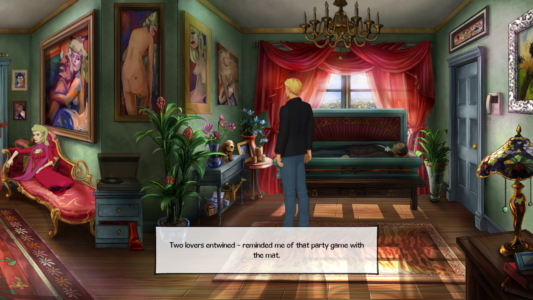
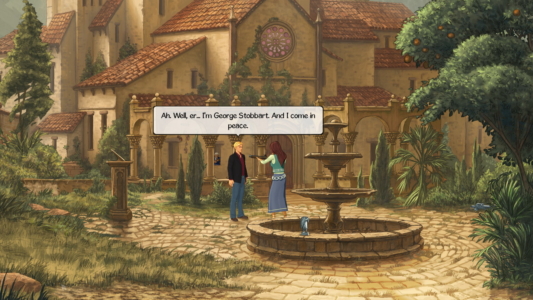
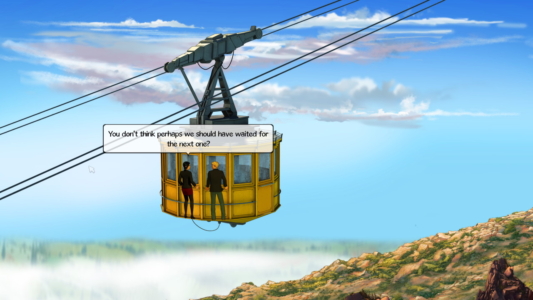

 Posts
Posts